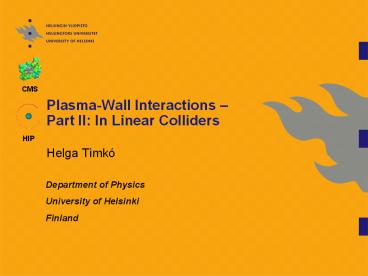Plasma-Wall Interactions PowerPoint PPT Presentation
1 / 15
Title: Plasma-Wall Interactions
1
Plasma-Wall Interactions Part II In Linear
Colliders
- Helga Timkó
Department of Physics University of
Helsinki Finland
2
Plasma-Wall Interactions Outline
- Part I In Fusion Reactors
- Materials Science Aspect
- Materials for Plasma Facing Components
- Beryllium Simulations
- Arcing in Fusion Reactors
- Part II In Linear Colliders
- Arcing in CLIC Accelerating Components
- Particle-in-Cell Simulations
- Future Plans for a Multi-scale Model
3
Last Week Arcing in Fusion Reactors
- Arcing continuous gas discharge, between
electrodes or within the plasma sheath - Causes in fusion reactors
- Erosion,
- Impurities
- And thus, plasma instabilities ? harder to reach
confinement - Research on arcing has been done since 1970s
- Search for arc-resistant materials, ideal surface
conditions - Theoretical and experimental modelling of arcing
in simplified geometries - All in all, in fusion reactors arcing not so
critical any more - But for future linear colliders it is!
4
CLIC Compact Linear Collideronly 47.9 km ?
- A proposed e- e linear collider, with a CM
energy of up to 3 TeV in the final design (cf.
LEP max. 209 GeV) - Linear colliders more effective than circular
ones - Can reach higher energies
- With CLIC, post-LHC physics can be done, e.g. for
Higgs physics this means - LHC should see Higgs(es), should rule out some
theories - CLIC would be able to measure particle properties
- To be built in
- three steps
- Two-beam
- acceleration
5
CLIC accelerating components
- Under testing in the CTF3 project at CERN
- Too high breakdown rates, 10-4, aim 10-7 for
final design - Different setups have been tested
- Geometries
- Materials Cu and Mo best
- Frequencies main linac fRF
- was lowered 30 ? 12 GHz
- Most challenging is the high
- accelerating gradient to be
- achieved, already lowered too
- 150 ? 100 MV/m
- Need a theoretical model
- of breakdown to systemise
6
What is PIC and what can we simulate with it?
- PIC Particle-in-Cell method
- Basic idea simulate the time evolution of macro
quantities instead of particle position and
velocity (cf. MD method) - Need superparticles
- Restricted to certain regime of particle density
given by reference values (those define
dimensionless quantities) - Kinetic approach of plasma, but can be applied
both for collisionless and collisional plasmas - Many application fields solid state and quantum
physics as well as in fluid mechnics - Has become very popular in plasma physical
applications - Esp. for modelling fusion reactor plasmas (sheath
and edge)
7
The PIC Algorithm
- Setting up the
- simulation
- Grid size, timestep,
- superparticles, scaling
- Solving the equations of motion particle mover
- Moving particles, taking collisions BCs into
account - Calculating plasma parameters, macro quatities
- Solving Maxwells equations, (Poissons eq. in
our case) - this can be done with different solvers
- Obtaining fields and forces at grid points
- In PIC, everything is calculated on the grid,
interpolation to particle positions is done by
the weighting scheme
8
Solvers forthe Particle Mover and the Poissons
Equation
- Discretised equations of motion
- In 1D el.stat. case, with the leapfrog method, in
the Boris scheme - Poissons equation determining the electric field
from charge density values at grid points
9
Scaling in PIC Grid size and timestep
- In the code, everything is scaled to
dimensionless quantities ? easier to analyse
physically, faster code - Initial values give the scale for the
simulations, only a few orders of magnitudes can
be captured - Need a good guess n0 1018 cm-3, Te 5 keV
- Determines ?D 5.310-7 m and ?pe 5.61013
1/s, the internal units of the code - For an arc, densities are only rising! ? model is
limited - Stability conditions
- Compromise btw. efficiency and low noise
- ?x 0.5 ?D, ?t 0.2 1/?pe
- Amazing whole set of equations can be rescaled ?
universal results only the incl. of collisions
gives a scale
10
Our Model
- In collaboration with the Max-Planck-Institut f.
Plasmaphysik, Greifswald - 1D electrostatic, collision dominated PIC scheme
- Simplistic surface interaction model
- Assuming const. electron thermoemission current
(cathode) - Const. flux of evaporated neutral Cu atoms,
Icu0.01Ith,e - Cu ions sputter Cu with 100 probab., neutral Cu
is reflected back when hitting the walls
11
Including collisions
- Arcing highly collision dominated, so is our
model - Including only 3 species electrons, neutral Cu,
Cu ions - Multiply ionised species ignored
- Most important collisions are taken into account
12
A Typical Output
- Macro quantities as a function of time
- Flux and energy distributions, currents
- Note the sheath!
- Animations by K. Matyash
13
The Plasma Sheath
- Sheath a thin layer of a few Debyes near the
wall - All physics happens in the sheath
- Field density gradients, collisions
- Outside, the potential is constant, field is
zero Doesnt really matter what the dimensions
of the system are (nm or µm)
14
Future plans Integrated Modelling of Arcing
- Multi-scale model aimed an integrated
- PIC MD model of arcing
- Collaboration between
- Max-Planck-Institut für Plasmaphysik
- Helsinki Institute of Physics
MPI Greifswald K. Matyash R. Schneider HIP,
Helsinki H. Timko F. Djurabekova K. Nordlund
15
Thank You!
- Bibliography
- D. Tskhakaya, K. Matyash, R. Schneider and F.
Taccogna The Particle-In-Cell Method,
Contributions to Plasma Physics 47 (2007) 563. - Computational Many-Particle Physics, Springer
Verlag, Series Lecture Notes in Physics,
Vol. 739 (2008) - Editors H. Fehske, R. Schneider and A. Weiße
- Information
- http//clic-study.web.cern.ch/clic-study/
- http//beam.acclab.helsinki.fi/knordlun/arcmd/

